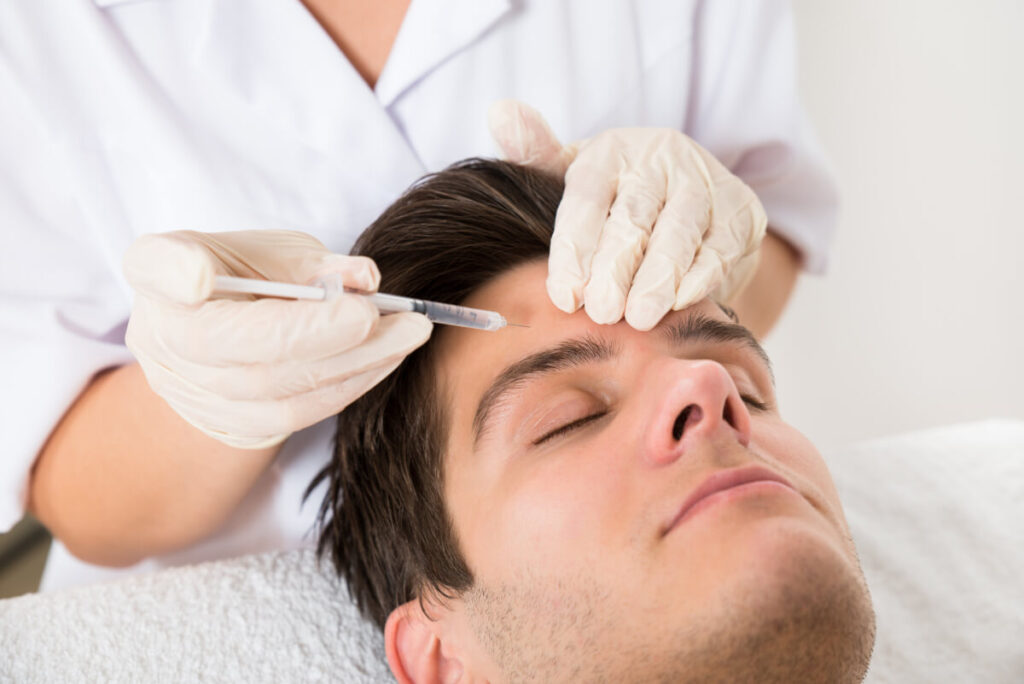Is Neck Pain after Botox Injection for Migraines Serious?

When people hear of Botox, the first thing that comes to their minds is the injectable drug that erases fine lines, wrinkles, and other signs of aging. But aside from its cosmetic uses, Botox injections are also utilized for treating different medical conditions like cervical dystonia, upper limb spasticity, myofascial pain, hyperhidrosis, chronic migraine, and more.
But is it normal to experience neck pain after using Botox injection for migraine? While using botulinum toxin injections for migraine is relatively safe, some patients might still experience common side effects like neck pain. This usually lasts for a few months until the neurotoxin is metabolized by the body.
With just a few simple injections, our providers can erase your wrinkles and fine lines in no time with Botox. Call us today to book your appointment.
Does Botox for Migraines Cause Chronic Neck Pain?
Botox cosmetic injections are safe and popular anti-aging treatments that reduce the appearance of dynamic wrinkles in the different areas of the face by relaxing the overworked muscles. According to the American Society of Plastic Surgeons, there were a total of 4,401,36 Botox procedures performed in the country in 2020 alone.
But before Botox was approved for eliminating forehead lines in 2002 and crow’s feet in 2013, the neurotoxin was first approved as a treatment for a few medical conditions – including strabismus, hyperhidrosis, myofascial pain, cervical dystonia, upper limb spasticity, and chronic migraine.
The Botox cosmetic introduced by Allergan is an injectable drug derived from the botulinum toxin type A produced by the bacteria called Clostridium botulinum. The injectable only uses a small dosage of neurotoxin to block nerve signals and stop the muscle contraction in the treatment area.
Botox injections are safe as long as they’re administered by an experienced medical professional. However, patients are still at risk of developing common side effects including muscle spasms, stiffness, or pain at the injection sites and nearby areas.
Read more: Differentiating Therapeutic Botox for Migraines vs Cosmetic Botox
Everything You Need to Know About Botox Injections for Migraine
Want to find out if Botox injections are the right migraine prevention treatment? Like other chronic pain management procedures, it’s important to consult with a physician first to see if you’re a qualified candidate for the treatment. Here’s everything to know about Botox injection first before utilizing the treatment:
How Does it Work?
Headache is a common complaint that’s caused by psychological or physical stress (tension headache) or sinus pressure (sinus headache). Some headaches might also happen around the same time every day (cluster headaches). If the headache disorder is accompanied by other symptoms like light or sound sensitivity, then the patient might be suffering from a migraine.
An acute migraine headache usually lasts from a few hours to days, but it’s considered a chronic migraine if the patient has headaches that last for about 4 hours on more than 15 days in a month. Some of the migraine symptoms show in different stages:
- Before – Migraine patients might experience vision changes, which causes them to see light flashes or have blind spots. They might also feel buzzing or tingling sensations for a few hours or days before having a headache.
- During – In addition to the throbbing headache that lasts for hours to days, a migraine sufferer also has increased sensitivity to sound and light. Some patients also feel nauseous during a migraine attack.
- After – This stage is called “migraine hangover” because patients tend to be tired and irritable more than usual. They also have trouble performing different daily activities because of the lingering migraine pain in their head.
Botox injections work by reducing the frequency of these chronic migraine headache episodes. The neurotoxin blocks the pain signal and stops the nerves from releasing acetylcholine, a neurotransmitter that tells the pain fibers, as well as head and neck muscles to contract or spasm. With fewer days of episodic migraine per month, patients slowly return to their normal routines without much problem.
How Many Injections Do You Need?
Botox appointments are typically performed inside a doctor’s office for about 30 minutes. Patients don’t need to prepare anything, but they’re often asked to avoid taking certain medications that might affect the migraine treatment a few days before the appointment.
The physician might apply a topical anesthetic on the skin to numb the area if the patient requests it. The Botox is injected using a small needle on different parts of the neck and head where the patient feels headache pain. The exact number of units injected varies per patient, but the average dosage is 155 units divided into 31 injections across 7 specific head and neck areas.
Each botulinum toxin injection feels like a slight pinch on the skin, but it’s tolerable for most patients. They’re also allowed to return home immediately after the appointment, but they might need assistance from a friend or family member.
Is Botox the Right Treatment for Your Migraine?

While there are enough studies to prove the safety and effectiveness of Botox for relieving chronic headache and migraine, it might not be the best procedure for everyone. Chronic migraine sufferers aren’t qualified for Botox injections if:
- They’re allergic to botulinum toxin.
- They have a history of botulism.
- There’s an active infection near or on the injection site.
- They’re diagnosed with a medical condition that causes muscle weakness like myasthenia gravis or amyotrophic lateral sclerosis (ALS).
- They’re pregnant or nursing.
It’s also important for patients to be aware of the important pieces of information about Botox before trying the treatment. Here are some questions to ask yourself before considering Botox for migraine:
- How often are the migraine attacks? Botox helps treat a chronic migraine that occurs an average of 15 days per month. If the migraine isn’t chronic, it’s better to find out the source of headaches first to get the right treatment.
- Are you willing to undergo multiple treatments? Botox injections don’t always work after the first treatment. Even if it does, Botox isn’t a permanent cure. Patients who had Botox injections for migraines still need to return every few months for maintenance and preventive treatments.
- Is it covered by the insurance plan? Botox treatments tend to be expensive because of the units needed and the sessions required. Most insurance companies provide coverage for utilizing Botox for migraines, but they often require documents to prove that the patient has already tried and failed with other treatments.
Learn more: The Pros and Cons of Botox for Migraines
With just a few simple injections, our providers can erase your wrinkles and fine lines in no time with Botox. Call us today to book your appointment.
How Long Does it Last?
The first set of Botox injections don’t show results or improvements for the patient in the first 10 to 14 days. However, most of these patients respond to the neurotoxin well when the treatment is repeated. They report significant improvement in the headache day and intensity after their second or third set of injections.
Botox injections significantly decrease the number of days that a patient experiences headaches, but it’s not considered a long-term treatment. The body metabolizes the neurotoxin after a few months, which is why patients often return for maintenance injections every 12 weeks. Any more often than this might lead to serious complications.
How Much Does it Cost?
The exact cost of Botox treatment for migraine varies on the number of units needed, the provider’s experience, and the clinic’s location, but the national average is somewhere between $300 to $600 for about 155 units of Botox.
Some insurance companies include Botox injection therapy for migraines in their insurance coverage, but it’s important to consult with both the doctor and insurance agent first to find out how much is covered by the insurance company and how much is needed out of your pocket.
Possible Side Effects of Botox Injections for Migraine
Although Botox cosmetic has already been approved by the FDA for treating chronic migraines, it still comes with different common and serious side effects. Patients need to get the injectable from a trusted provider to avoid serious complications.
Mild and Common Side Effects
Botox might cause mild side effects for patients too, just like other medications used for preventing headaches. Most of these common side effects are temporary, lasting only for a few days up to weeks. But if the symptoms worsen or last much longer, it’s better to consult a doctor about the situation so that they may alter the medication plan. Some of the most common mild side effects of Botox injections are drooping eyelid, muscle spasm, neck pain, and pain at the injection site.
Serious and Long-Term Side Effects
Although they’re rare cases, patients might also have an allergic reaction to the Botox injection. The neurotoxin might cause life-threatening complications that prevent them from breathing and swallowing. Blindness might also occur if the Botox is incorrectly injected around the eye area. Remember to contact a physician right away if the patient develops serious side effects after getting Botox injections for migraines.
Read more: Using Botox for Migraine: Side Effects of the Treatment
How Often Do People Experience Neck Pain After Botox?

Neck pain is a common but mild side effect of Botox injections for migraines. According to the clinical trial of the neurotoxin, about 9% of the participants who had Botox injections for chronic migraines experienced neck pain after the treatment.
What Should You Do If You Have Neck Pain After Botox?
The pain usually subsides a few days or weeks after the treatment, as the body metabolizes the neurotoxin injected in the different areas of the head and neck. If the pain becomes too severe for the patient, the doctor may prescribe pain relief medications as long as it doesn’t react negatively with the neurotoxin.
How to Avoid Neck Pain and Other Botox Side Effects
Botox has made a world of difference for many chronic migraine patients when it comes to reducing the severity and frequency of migraine attacks. Only a handful of patients experience side effects, but it’s possible to avoid these complications altogether by following a few precautions. Here are some of the best ways to prevent neck pain and other Botox side effects for migraine patients:
Preparing for the Procedure in Advance
Since Botox treatment is a non-invasive procedure, it doesn’t require a detailed preparation like surgery. But to ensure your safety, there are a few necessary steps to follow like:
- Choose a qualified and reputable medical practitioner to inject the neurotoxin into the head and neck. Cosmetic practitioners are qualified to administer Botox but utilizing Botox for facial wrinkles is different from injecting it for migraines. Ensure that the provider is experienced in injecting the neurotoxin into strategic places to treat chronic migraine effectively.
- Check the facility in which the treatments are performed. It’s essential to be in a well-prepared medical facility during the treatment so that the patient gets the medical care they need in case something goes wrong during the procedure.
- Tell the doctor about the full medical history. This includes family history, existing health conditions, and medications taken by the patient that might interact with the botulinum toxin.
- Avoid taking certain medications before the Botox appointment. This includes pain medications, medications for cardiovascular conditions, medications for neurological diseases, anticoagulants, and antibiotics.
- Don’t drink alcohol for at least two days before the Botox treatment. Alcohol only encourages bleeding and bruising during and after the procedure.
Reducing the Risk of Side Effects of Botox on the Treatment Day
- Pack a few over-the-counter NSAIDs with you before going to the clinic. This reduces the prostaglandin produced by the body, a hormone that causes inflammation and pain.
- Bring an ice pack to apply over the injection sites. This prevents the treatment areas from bleeding or bruising because the ice constricts the blood vessels. Make sure to wrap it in a clean towel or cloth so it doesn’t come in direct contact with the skin.
- Rest well right away after the procedure and limit the activities during the day. Patients are advised to avoid heavy physical activities for at least 24 hours to prevent the spread of the neurotoxin to other areas.
Following Aftercare Tips from the Botox Provider
- Drooping eyelids, bleeding, bruising, mild pain, and slight inflammation are common side effects that go away a few days or weeks after the treatment, but make sure to contact the provider immediately if the symptoms worsen or other concerning side effects show.
- Gently exercise the face to relieve pain, but don’t apply too much physical pressure on the treatment area. This causes the neurotoxin to travel to other parts of the face.
- Stay out of the sun or heat as much as possible. High temperatures cause flushing and increase blood pressure, which results in bruising. Aside from sun exposure, patients should also avoid hot showers, tanning beds, and saunas for about 24 to 48 hours.
- Postpone skincare treatments that were scheduled right after the Botox appointment. Facials, massages, and exfoliating scrubs reduce the effectiveness of the neurotoxin if they’re applied too soon.
Safe and Effective Botox Therapy for Migraine at aNu Aesthetics
Looking for a trusted Botox provider around Kansas? aNu Aesthetics is the premier wellness and aesthetics clinic in Kansas City that offers safe and effective Botox injections for both cosmetic and medical purposes. Our team of highly trained staff led by Dr. Cristyn Watkins has a good reputation for delivering quality results and providing the best preventive treatment for every chronic migraine patient.
Here at aNu Aesthetics, we want to promote self-care, well-being, and optimal health among our patients through personalized care and services. Find out if you’re a good candidate for Botox therapy for migraines by calling us at (819) 359 – 3310 to book an appointment.
With just a few simple injections, our providers can erase your wrinkles and fine lines in no time with Botox. Call us today to book your appointment.